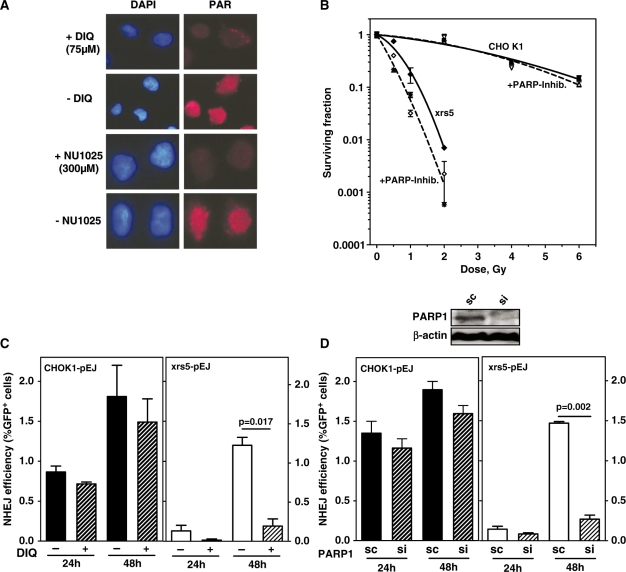Figure 4.
Alternative end-joining mechanism is PARP1-dependent. (A) xrs5 cells were X-irradiated (20 Gy) and immunostained after 20 min for obtaining PAR. Pretreatment with the PARP-inhibitors (DIQ or NU1025) completely abrogated nuclear PAR accumulation. (B) Cell survival of CHOK1 and xrs5 cells after X-irradiation (closed symbols, solid lines) alone or in the presence of either PARP inhibitor (open symbols, dashed lines) was carried out. An amount of 75 µM DIQ (asterisk) and 300 µM NU1025 (diamonds) led to equal radiosensitization in xrs5 cells (dashed line), but had almost no effect on CHOK1 (open triangles). The mean values of three independent experiments are shown. Data were fitted to the linear quadratic equation S/S0 = exp(–αD – βD2). The parameters obtained (α, β) were used to calculate the mean inactivation dose, Dbar (87) as a measure for the radiosensitivity. (C) NHEJ efficiency in the presence or absence of DIQ was determined as shown before (Figure 2) in CHOK1-pEJ and xrs5-pEJ clones (CHOK1-pEJ #70 and 71, and xrs5-pEJ #20 and 26). DIQ, given immediately after I-SceI transfection, significantly inhibited end-joining efficiency only in xrs5 cells. Data show the mean (±SE) of two experiments performed with two clones and three replicates each. (D) PARP1 was depleted from cells carrying pEJ by transient siRNA transfection 24 h before end-joining experiments were started as described before. (Immunoblot shows PARP1 expression 24 h after siRNA treatment.) The significant difference is indicated. sc indicates transfection with unspecific ‘scrambled’ siRNA. si indicates siRNA specifically targeting PARP1. Data show the mean (±SE) of two experiments performed with three replicates using a single clone of each strain.

